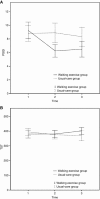Effect of walking on circadian rhythms and sleep quality of patients with lung cancer: a randomised controlled trial
- PMID: 27811855
- PMCID: PMC5129819
- DOI: 10.1038/bjc.2016.356
Effect of walking on circadian rhythms and sleep quality of patients with lung cancer: a randomised controlled trial
Abstract
Background: Sleep disturbances and poor rest-activity rhythms, which can reduce the quality of life, are highly prevalent among patients with lung cancer.
Methods: This trial investigated the effects of a 12-week exercise intervention including home-based walking exercise training and weekly exercise counseling on 111 lung cancer patients. Participants were randomly allocated to receive the intervention or usual-care. Outcomes included objective sleep (total sleep time, TST; sleep efficiency, SE; sleep onset latency, SOL; and wake after sleep onset, WASO), subjective sleep (Pittsburgh Sleep Quality Index, PSQI), and rest-activity rhythms (r24 and I<O). Outcomes were assessed at baseline and 3 and 6 months after intervention.
Results: The PSQI (Wald χ2=15.16, P=0.001) and TST (Wald χ2=7.59, P=0.023) of the patients in the exercise group significantly improved 3 and 6 months after intervention. The moderating effect of I<O on TST was significant (β of group × I<O=3.70, P=0.032).
Conclusions: The walking program is an effective intervention for improving the subjective and objective sleep quality of lung cancer patients and can be considered an optional component of lung cancer rehabilitation.
Figures



References
-
- Baiden P, Fallon B, den Dunnen W, Boateng GO (2015) The enduring effects of early-childhood adversities and troubled sleep among Canadian adults: a population-based study. Sleep Med 16(6): 760–767. - PubMed
-
- Berger AM, Hertzog M, Geary CR, Fischer P, Farr L (2012) Circadian rhythms, symptoms, physical functioning, and body mass index in breast cancer survivors. J Cancer Surviv 6(3): 305–314. - PubMed
-
- Borg G (1998) Borg's Perceived Exertion and Pain Scales. Human Kinetics: Champaign, IL.
Publication types
MeSH terms
LinkOut - more resources
Full Text Sources
Other Literature Sources
Medical

